What would we have predicted for Kuwait?
Posted by Stuart Staniford on January 20, 2006 - 9:06pm
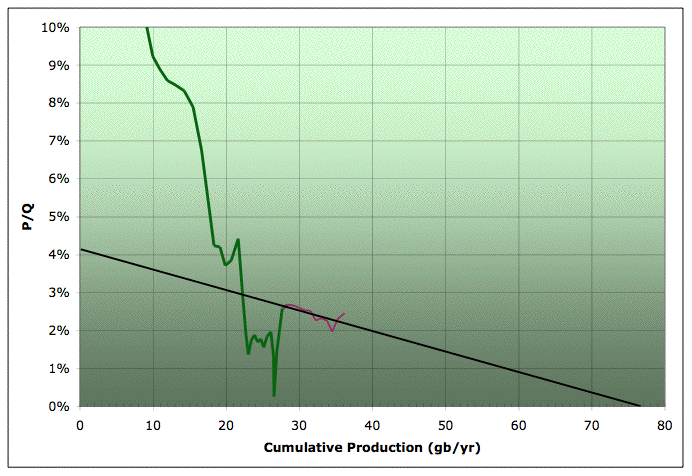
Linearization of Kuwaiti oil production. Data source: American Petroleum Institute (via Jean Laherrere) and BP Statistical Review of World Energy. Click to enlarge.
Update [2006-1-21 2:25:16 by Stuart Staniford]: More graphs and a stability analysis added to the story below the fold.
"PIW learns from sources that Kuwait's actual oil reserves, which are officially stated at around 99 billion barrels, or close to 10 percent of the global total, are a good deal lower, according to internal Kuwaiti records," the weekly PIW reported on Friday.I have personally never believed the publicly claimed numbers since the whole issue came to my attention. This graph just reeks:It said that according to data circulated in Kuwait Oil Co (KOC), the upstream arm of state Kuwait Petroleum Corp, Kuwait's remaining proven and non-proven oil reserves are about 48 billion barrels.
Officials from KOC were not immediately available for comment to Reuters. PIW said the official public Kuwaiti figures do not distinguish between proven, probable and possible reserves.
But it said the data it had seen show that of the current remaining 48 billion barrels of proven and non-proven reserves, only about 24 billion barrels are so far fully proven -- 15 billion in its biggest oilfield Burgan.
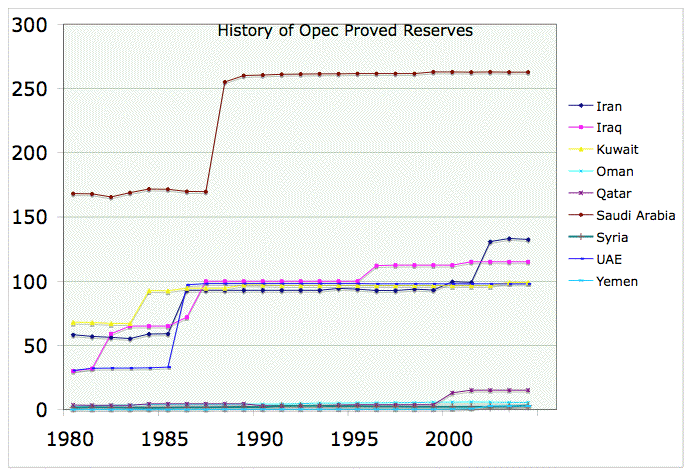
History of OPEC claimed proved reserves. Source: BP Statistical Review of World Energy. Click to enlarge.
So, presumably the amount of oil left to pump, if PIW has the story straight, is somewhere north of 24gb, and perhaps south of 48gb. So what would our linearization have told us? I can't find that anyone did the exercise before, but I have production data from BP, and Jean Laherrere recently very kindly supplied me with a bunch of early data from an American Petroleum Institute study in 1958 (centennial year of US oil production). The production graphs looks like this:
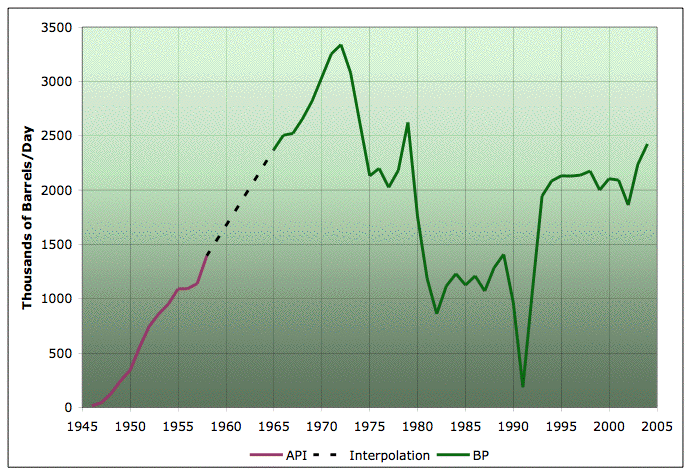
History of Kuwaiti oil production. Data source: American Petroleum Institute (via Jean Laherrere) and BP Statistical Review of World Energy. Missing years have been linearly interpolated. Click to enlarge.
I have had to interpolate between 1958 and 1965, but it looks like that won't be too much in error. Note that the mathematical form of this data is a little more complex than either a logistic or a Gaussian :-). However, if we press boldly ahead on the theory that the linearization procedure is a robust if rough estimator even when the data sucks, we get:

Linearization of Kuwaiti oil production. Data source: American Petroleum Institute (via Jean Laherrere) and BP Statistical Review of World Energy. Line is fitted to data in purple only. Click to enlarge.
The straight line is fit to the purple data only, which is the nearest thing to a linear regime in this mess. Amazingly, the intercept is at 76gb. Given that current cumulative production is 36gb, this suggest there is 40gb to go. So this is in decent general agreement with the (24gb,48gb) range from the internally leaked information that Petroleum Intelligence Weekly has gotten hold of.
That suggests Kuwait is at 47% of their ultimate recovery - so close to the half-way point. Future declines are projected to be modest based on the K of just over 4%.
Finally, just to remind you of the implications for Saudi Arabia:

Hubbert Linearization of Saudi Oil Production. Credit Jean Laherrere. Click to enlarge.
If the same procedure works, they have produced 105gb out of 180gb or so, and are at around 55%-60% of their ultimate recovery. Note however that the K is higher at around 7%, suggesting significant declines ahead.
Update [2006-1-21 2:25:16 by Stuart Staniford]:
In comments, there was some discussion of the recent uptick in Kuwaiti production visible in the linearization. Here it is - this next graph is the monthly Kuwaiti production according to the EIA Table 1.1a
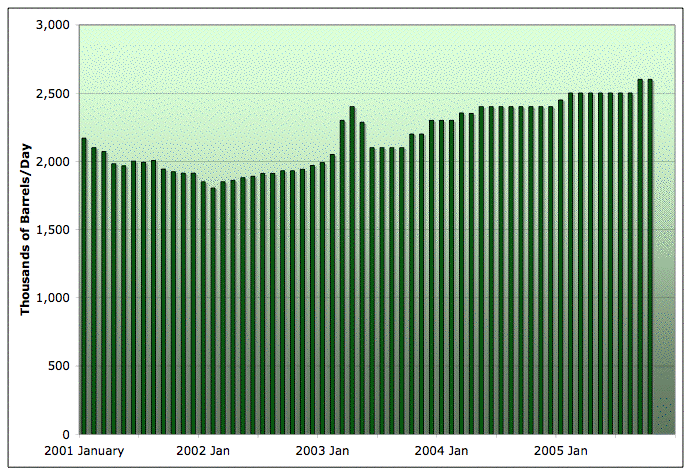
Monthly Kuwaiti oil production from January 2001 to October 2005. Data source: EIA Table 1.1a.
It doesn't look like that graph has finished increasing, despite the reports of near-term decline fears at Burgan. However, if we look at the percentage increase from the same month one year ago, we see the rate of increase is slowing down (roughly).
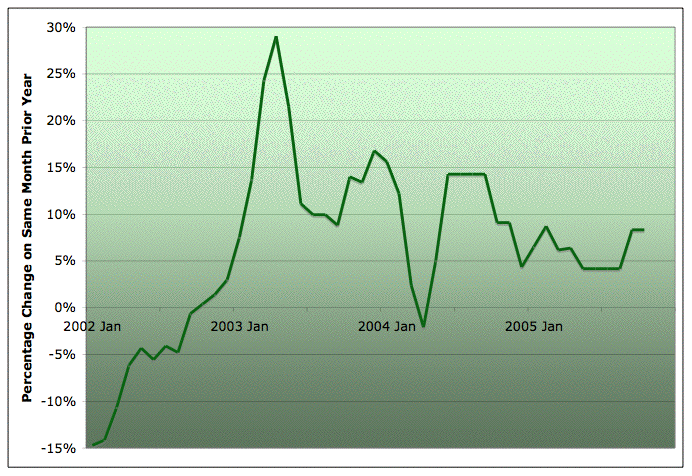
Year-on-year increase in Kuwaiti oil production for each month from January 2002 to October 2005. Data source: EIA Table 1.1a.
Update [2006-1-21 2:25:16 by Stuart Staniford]:
Don't read this next part unless you like highly technical discussions.
It should be obvious that in the linearization, taking a great big leaping extrapolation off that little linear area has got to be a rough approximation at best. Stability analysis confirms that. Probably the linearization estimate of URR is only good to a factor of 2 or so (with probably a larger error bar on the downside than the upside). K is maybe uncertain by 50%.
Recall that we developed an error estimation methodology for Hubbert linearization based on varying the start and end years of fitting the line and seeing how much the estimate changed. If it's very sensitive to the choice of years, then one has correspondingly less confidence in the extrapolation. This allowed us to place reasonable error bars on the US production (which is quite a mature area). Kuwait is much less certain, since it is less mature, and has had very large production variations for non-geological reasons.
Anyway, here's the stability surface, or perhaps instability surface would be a better term, for K:
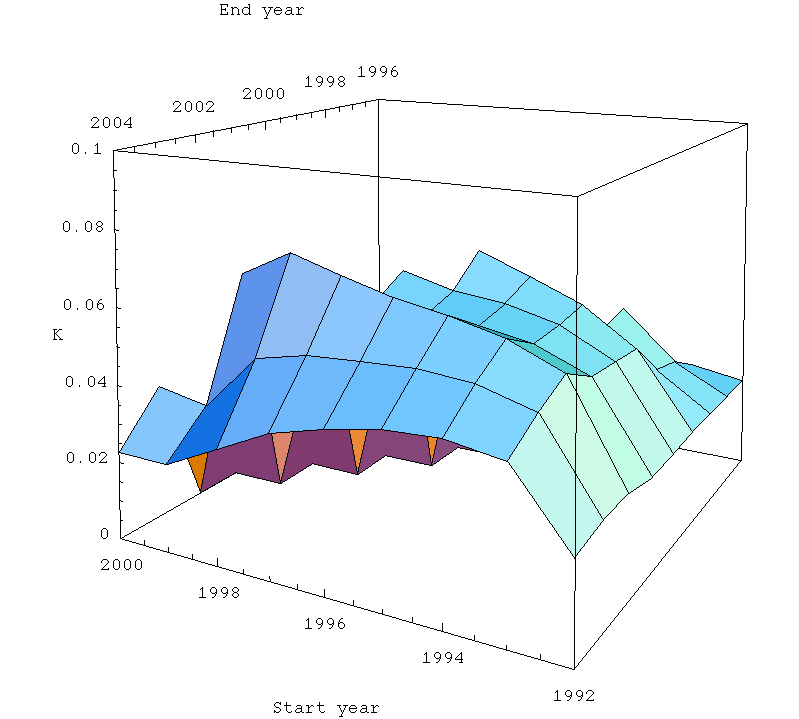
Hubbert linearization estimate of Kuwait's K (y-axis intercept which controls speed of decline) as a function of start year and end year of fit. Click to enlarge.
The same thing as a density plot:
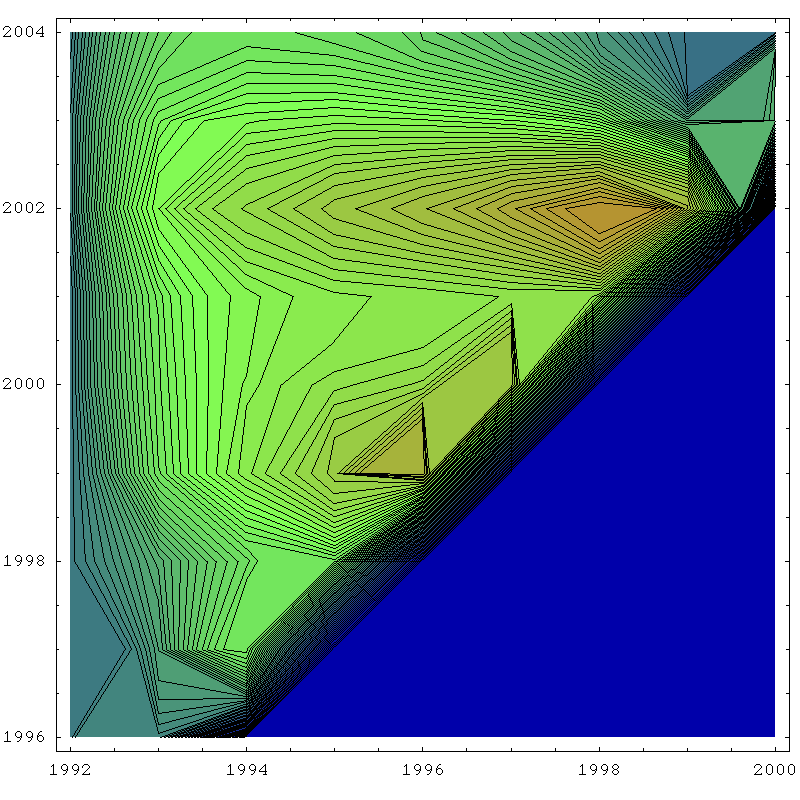
Hubbert linearization estimate of Kuwait's K (y-axis intercept which controls speed of decline) as a function of start year and end year of fit. This is a density plot from 0 to 10%, with 100 contours. Blue is zero, red is 10% or above, green is 5%. Click to enlarge.
Surface of the ultimate recovery estimate. Note that without the recent increase in production, we'd be estimating lower.
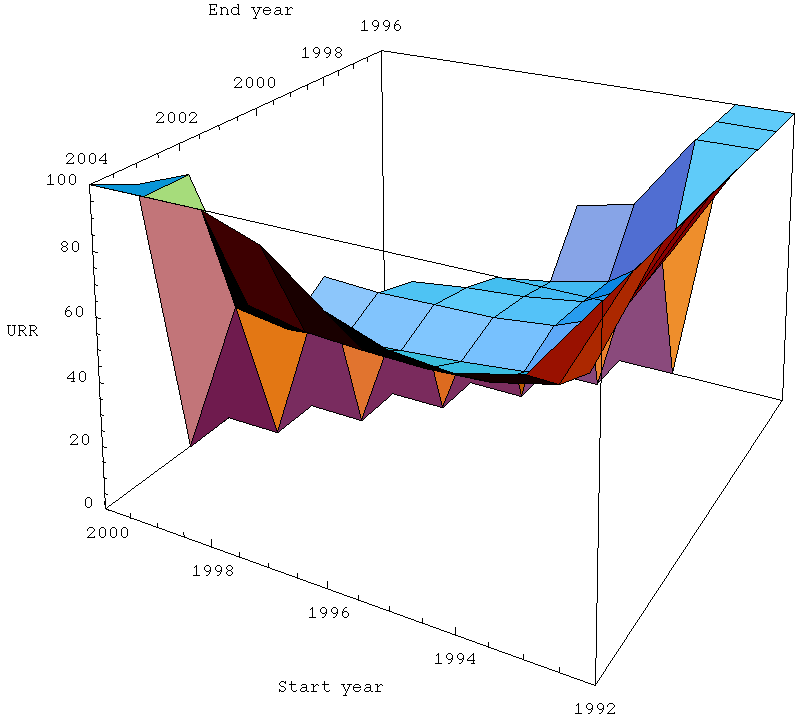
Hubbert linearization estimate of Kuwait's URR (eventual total recovery of oil in gb) as a function of start year and end year of fit. Click to enlarge.
The same thing as a density plot.
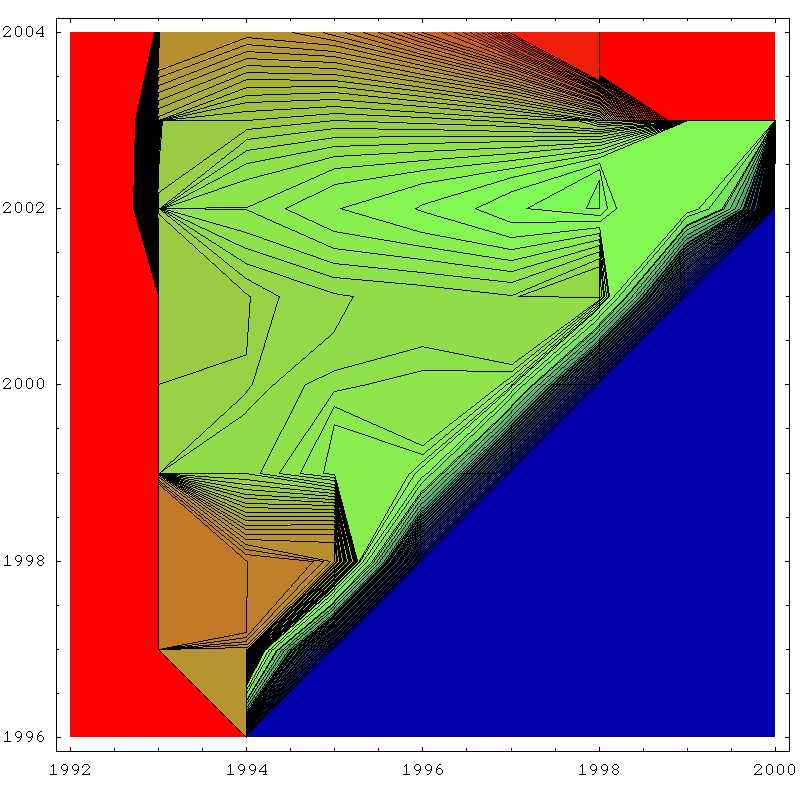
Hubbert linearization estimate of Kuwait's URR (eventual total recovery of oil in gb) as a function of start year and end year of fit. This is a density plot from 0 to 100gb, with 100 contours (ie each contour is 1gb). Blue is zero, red is 100gb or above, green is 50gb. Click to enlarge.




You are getting good.
So great to have sites like TOD.
Stories like these, would never get to the public without curious people on the hunt for facts.
Interesting that both went "linear" at about the same time, 1991 for SA and 1994 for Kuwait, and that both have made excursions above the fitted line the past couple of years.
If, when looking at other similar but more mature examples, we find that Stuart's linear fit is a reliable predictor of URR, perhaps we would be justified in using those URR numbers rather than the suspect OPEC numbers?
For now I would be cautious in reading too much into the Reuters report which is pretty damn vague. The detail will be important, what are the reserves by field, especially Burgan? There may be direct implications for some of Iraq's southern reserves.
If the Reuters report is accurate this news could be quite seismic. On the bright side it may create overwhelming pressure for a proper audit and assessment of mid east reserves. On the dark side, if Stuart's method of calculating URR for Saudi and Kuwait is an accurate predictor we are possibly past global half way in producing URR, since about 100 billion barrels have just evaporated.
Seismic indeed since if
And Campbell has been right all along.
Fantastic work Stuart!
And man, that Saudi Arabia graph is scary-looking.
It would be interesting to see if they all predict similar reserves to the figures before the bogus reserve hikes of the 80s.
Any bets on if this news will even be picked up by the "mainstream" media?"
Looking at the OPEC graph, it's also "interesting" how Iran's reserves have been so heavily inflated twice since '85. It's like magic!! Is Harry Potter Persian? It certainly makes me wonder how effectively the "oil weapon" can be wielded and for how long.
Stuart (and the rest of TOD crew) thanks for your passion for this topic. Our overall political leadership is not interested and would just as soon keep JQ Public in the dark.
no seriously, we do this because we have a great community here. This community makes this worthwhile...so thank you.
I can't name a big, respected, newspaper that has entertained the possibility of genuine oil scarcity. Has Simmons been interviewed by the NYT or WashPost? Have Deffeye's or Kunstler's books been reviewed?
The NYT is charging for the complet article, but I found a copy on the web here.
Simmons is mentioned more times than Daniel Yergin is just about every news source there is these days mentioning oil.
Peter Maass has been mentioned. He actually wrote abother one about a month ago in the NYT Mag.
Again this is fantastic work.
This Reuters piece and your analysis prove that Kuwait is on a one track slope and all that proven reserves were never proven at all. The day of truth is looming for SA.
Here's another ironic thing. It's amazing how this article has leaked out just after the recent death of the Emir in Kuwait.
Linearization is leading us closer to the fact that serious problems loom and paper barrels don't matter when all is said and done.
I suspect that if you used Linearization on some listed oil companies the true and fair reserve numbers are false and there is probably a whole heap of exploration costs carried forward against reserves, which will never happen and should be written off.
Keep up the great work.
What was that Soap Opera? I believe it was called "As the World Turns".
best, Dave
I looked at Colin Campbell's estimate for Kuwait in newletter 38 (Feb 2004) on the ASPO Ireland web site. His figure for remaining future production was 58.5 bn. Subtract 1.8 bn for production since then gives 57 bn. That figure includes 4.9 bn from undiscovered fields. Not much different from TOD.
"This hike in OPEC countries' estimates of their reserves was driven by negotiations at that time over production quotas, and had little to do with the actual discovery of new reserves"
Later in the WEO 2004, this analysis was dropped for some mysterious reason and the USGS 2000 mean estimate was adopted as a basis for IEA projections.
My summary report with a lot of links on this topic can be found at:
www.pc.gov.au/inquiry/energy/subs/sub075attachment2.pdf
For the benefit of everyone who has not done these plots, the key to getting an accurate plot is to obtain as much production data from the early years as possible. Once you have the early data, you can use the EIA data or other sources to finish the plot. For example, the Texas Railroad Commission has Texas production data starting in 1935. To get an accurate plot, I had to dig out an estimate of pre-1935 cumulative produciton (3.5 Gb).
One other point. Saudi Arabia, Russia, Norway and Iran account for more than half of net world oil exports. We have P/Q versus Q plots for all of them except Russia. Anyone want to volunteer? I think the only way to handle the data is to look at a plot of Soviet Union production and Russia + the FSU Republics. The three plots that we do have show that all three are at, or beyond the 50% of Qt mark. I strongly suspect that a Russian/FSU plot will also show them to be at or beyond the 50% mark. This topic alone would make a very good article--"Hubbert Linearization Analysis of Top Net World Oil Exporters."
Consider the implications of the four countries accounting more than 50% of net world oil exports going into a permanent and irreversible decline in production. I disagree with the Neocons move in the Middle East, but you certainly begin to understand their reasoning. Kenneth Deffeyes predicted that we would see a war for the remaining oil reserves; he just hoped that it would be fought with dollars and not with nuclear weapons.
original
original
Production data are BP + Laherrère (Russian Oil Production, letter to Walter Youngquist [2005 June 19]). Looks a little bit too pessimistic to me, Laherrère forecast URR= 200Gb for Russia. The last rebound in production has a good influence on the linearization result.
Original image
Original image
So Westexas observation is that Russia, Iran, Norway and Saudi Arabia account for over 65% of the top 10 oil exporting nations.
Can you stack those 4 together to come up with the coming production projections using hubbert linearization? Then we can use the consumption figures/estimates for those 4 countries to see how much export their might be going forward.
I for one, am coming to the grim conclusion that either Hubbert methodology for the 'world' will be proven wrong (less and less likely) or we are soon (next 5 years) in for a steep decline in oil availability worldwide.
a) can you (I?) determine the points from today forward on the regression line in bbl/day or bbl/year? Iran and Saudi have doubled their internal consumption over past 15 years, ( Russia and Norway have actually decreased internal oil consumption). As of 2004, those 4 countries consumed 6 million barrels per day and exported 21 million.
So whats really happening is 1)numerous hubbertian peaks are being reached 2)internal consumption in exporting countries is rising 3) second half of hubbert graph is lower quality and deeper requiring more energy to produce (Net EROI is lower) and 4) overall world population and benchmarks (therefore demand) is increasing. So the net/net/net left is less. The combination of these 4 points makes me want to buy an oil future in the morning.
b) in a tally, how often do the upturns in recent years end up reverting to original red hubbertian line and how often do they end up meaningfully changing ultimate Qt? In other words, had you done this analysis in 2001 instead of today it would have presumed a much lower final Qt - Is there enough world history to conclude much on this?
It's a good question. I think that the possibility of a late modification of Qt is related to the discovery curve (ex: is there a lot of yet-to-be-find) and the time between discovery and the first producing well which depends mainly on political and economical factors. If we look at Russia, they seem to have a very mature production but they managed to push up production anyway. Note that this increase is not influencing the result of the Hubbert Linearization yet because of the important weight of the past production.
To me, one of two things will happen -either those 4 nations peak in production very soon and start to deplete faster than average (because production is increasing PAST the halfway point), or Hubberitan linearization trips up when extrapolating to the world. What am I missing here? Is this like the Hotelling chart by Gowdy referenced a few weeks ago, that shows technology basically borrowing from the right half of distribution making it 'appear' as if the whole distribution will be bigger?
Thanks for your efforts Khebab - I dont know how to graph those otherwise I would.
The Russian data may well be skewing the analysis. Would it be easy enough to drop Russia and see how the remaining three countries model? Perhaps Russia could then be modelled separately and the results added?
I do realise we are playing with somewhat flaky data - in the sense that exogenous events have significantly affected it, as well as possible inacuracies - but recent analyses here have been ominous. I don't think that is just in the eyes of the beholders, nor just in the eyes of the analysts who've been doing the excellent work.
Khebab, do you have discovery data? It seems to that the recent upturn in FSU production is due to a new cycle of discovery in the republics outside the Russian Federation.
Note that Saudi Arabia, at about 55% of Qt, has been pretty much stuck at 9.5 mbpd (crude + condensate) since June of 2004, according to the EIA:
http://www.eia.doe.gov/emeu/ipsr/t11a.xls
Before production starts to fall, it stops increasing.
Note that the Hubbert Linearization method was far more accurate in predicting the North Sea production peak (and steep decline) than the reservoir engineers with the largest oil companies in the world, who were predicting a peak around 2010, with a very gradual decline rate.
While obviously most of us here believe there are serious questions about Saudi's ability to produce, it must be said that they have historically been and remain for all intents and purposes the "swing producer." And swing they do.
Notice the recent report of them cutting 100,000 bpd when nobody here can figure out why, when global supply/demand is so tight. Saudi propaganda is hilarious to the Western ear, but is it meant to obfuscate, rather than deceive.
I still don't see definitive evidence that they can't produce 12mbpd.
If there are very few big fields left to be found and if oil prices are going up to $200 per barrel in 2005 dollars by 2010 (Simmons' prediction), major oil companies are going to be making a killing producing their remaining reserves, and they won't be able to replace their reserves at anything remotely like the rate that they are producing them.
Consumers will scream for government to do "something." "Something" would most likely be higher taxes. So, would you expect major oil companies to admit that they can't replace their reserves or would you expect them to say that they need the cash flow to bring on new reserves? As Matt Simmons has pointed out, this also is a factor all around the world regarding Production Sharing Agreements (PSA's). The problem of course is that major oil companies only control a tiny percentage of reserves worldwide.
Which brings us to OPEC. Would you expect the OPEC countries, which are militarily weak compared to the big consuming nations, to admit that they also can't replace their reserves or would you expect them to tell everyone not to worry?
Actions speak far louder than words. Consider the current events in the Middle East in light of the foregoing.
Here's a challenge: does anyone know what portion of US federal government income derives from oil and similar energy resource leases? I have dug around the .gov sites and this number is surprisingly elusive.
Great job, (and fast). Two questions.
a)On your main linearization graph for Kuwait, clearly the purple P/Q vs Q takes an upward jog in the past few years. How often does this happen in past-peak countries? Ever?
b)how does making assumptions of smoothing the offline production from Gulf War change the URR? (making some assumptions to what production would have been IF no war-teim shut down)
http://www.theoildrum.com/story/2006/1/11/6047/13568
The gas at your local store was bought a month ago when oil was much lower - there is a refining/transportation/wholesale/retail lag to the process that ends up being several weeks. Rest assured retail gasoline prices will be increasing soon.
I have read that, generally, the national average retail price is $0.60 greater than the wholesale price, with variation from state to state; this seems to be true. See:
http://tonto.eia.doe.gov/oog/info/gdu/gasdiesel.asp
Right now they're showing an average price of $2.32, which is about $0.50 higher than the wholesale price.
http://www.tradearabia.com/tanews/newsdetails_snOGN_article99503_cnt.html
Well, what do you "think" buddy?
What a powerful statement by KOC!
Nothing to see here keep moving.......
Bullshit. The line is dead flat except when it takes a massive leap. These guys aren't even good liars.
How long can he keep up the charade that Saudi Arabia will "soon" double its proven reserves, when in fact, it looks like those reserves should more likely be halved.
I think most of us knew all along, just as Campbell did, that the 1980's adjustments had no basis in reality. Actually, I've been waiting for the day when the asserted OPEC reserves bubble would burst. And that day has finally come. It's not too surprising that the news came out of Kuwait. If you recall, during the ASPO USA conference back in November, Kuwait announced that they had reached a peak production number for Burgan (1.7/mbpd--though this number itself may be on the high side. I believe current production there is closer to 1.4/mbpd). This was a startling admission at the time and I suppose it was inevitable that further information confirming our worst fears would come from the Kuwaitis. Here's an ASPO Ireland article Kuwait Confession written shortly after the original announcement about Burgan. Stuart's linearization intercept indicates 76 Gb with 36 Gb already produced. Here's what that ASPO Ireland article had to say at the time. These numbers are very close to Stuart's estimates, so we're all in the same ballpark (76 Gb versus 86 Gb). The difference may partly be due to the fact that Stuart uses 36 Gb for cumulative production while ASPO Ireland quotes 32 Gb as of December 2004. This makes both analyses fairly close as far as remaining reserves go at the higher end of the 24 to 48 Gb range Stuart gives but we've got two points of uncertainty--1) the cumulative production to date and 2) the actual reserves number. Just making a Wild Ass Guess, I would say that the oil left to produce in Kuwait is probably nearer the 48 Gb number and that Stuart's Hubbert Linearization estimation predicting his Qt number is based on messy and still incomplete data, as he is the first to admit. But still, his approximation is certainly plausible and both estimates are reasonably close. But we can close the book on the 99 Gb figure that Kuwait has claimed and never revised in the recent past.
When we discuss production here at TOD, we have been recently been using the 85 mbpd number. 13% of this number(rather large if you ask me) is made up of NGPLs, RPG, lease condensate, and "other liquids."
Yet, in this particular example of Kuwait, Stuart, you are using table 1.1a which only includes lease condensate. To get the number for Kuwait that we use in the 85 mbpd number we would have to take into account the roughly 6% of these other liquids that Kuwait produces.
The question is this: How significantly do you think including those 6%(Kuwait) and 13%(worldwide) numbers would effect the equations? Do they have no effect because they are simply percentages, or would they alter the graphs by billions of barrels and a few years?
I guess it all evens up in the end.
If you look at the Russian plot, oil production stopped growing at about 47% of Qt (I'm rounding off Qt at 160 Gb), around 1989. Production was basically flat for about 10 years until 1999, out to about 59% of Qt. Production then fell dramaticlly. Everyone assumed that it was because of the breakup of the Soviet Union, and then production rebounded strongly. However, the recent production is still significantly below the 1980's decade long peak. It looks like production peaked as a broad plateau center roughly on the 53% of Qt mark. In my opinion, and several others have made this same point, the rebound in Russian production was just making up for the falloff in production during the political problems.
The key point is that Russia is probably poised for a significant drop in production. In fact, if you believe the plot, Russia has less remaining recoverable reserves than does the U.S.
Following are the Hubbert/Deffeyes reserve estimates for the top four exporters, and the estimated life of reserve estimates, at current rates of production:
Saudi Arabia: 80 Gb & 21 years
Russia: 20 Gb & 6 (SIX?????) years
Norway: 9 Gb & 8 years
Iran: 60 Gb & 40 years
Total for all four: 169 Gb & 16 years. These four countries account for the majority of net world oil exports.
This is based on top four exporters in 2004:
http://www.eia.doe.gov/emeu/cabs/topworldtables1_2.html
IMO, the world economy is in deep doo-doo.
If I have made a mistake somewhere, could someone let me know? If this is basically correct we are heading for one hell of a collapse in net exports.
Russian production was basically flat from about 1979 to 1989.
(Also posted on Weekend Open Thread).
The Hubbert linearization for all four seems to give 557 - 310= 247 Gb left. We are maybe too pessimistic on Russia, I would say 50Gb left. Do you know what was Russia production for 2005?
In regard to Russian production, the most recent data I have seen is off the EIA website (I believe that it is basically flat year over year). In any case, I think that the key point is that Russia's production, while it has rebounded from the post Soviet Union collapse, has not reached the Eighties' peak. Therefore, it has not shown increasing production--relative to the Eighties peak--beyond 55% of Qt.
Based on the individual plots, following are the depletion percentages, for each of the big four--ranked in order of importance of net world oil exports:
Saudi Arabia, 55% depleted
Russia, 87% depleted
Norway, 67% depleted
Iran, 50% depleted
I'm using the following EIA data for daily production and exports: http://www.eia.doe.gov/emeu/cabs/topworldtables1_2.html
Russia: 87% depleted, remaining reserves 20 Gb, daily production 9.3 mbpd, P/Q intercept 11%
US: 85% depleted, remaining reserves 35 Gb, daily production 8.7 mbpd, P/Q intercept 5.5%
I think that we have been overestimating Russian production capacity because of the strong rebound from the post-Soviet collapse in production. Note that the North Sea P/Q intercept ACCURATELY predicted that the North Sea production would fall at a much faster rate than the Lower 48 US production.
Based on the Hubbert/Deffeyes method and the above scenario, who among us would consider the US to be a reliable source of oil exports in the years ahead?
Therefore, why should we consider Russia to be a reliable source of oil exports in the years ahead?
Yes it's a big spread and I don't know yet why the linearization of all four gives a greater estimate than the sum of all individual estimates. Lahèrrere made a plot for Russia (see my post above) with an URR @ 200Gb which gives him a production plateau starting in 2006 at 7.5 mbpd.
Below an unofficial estimate for 2005 Russia production (9.44 mbpd):
src: MosNews.com
I think we may begin to see a decline in 2006 for Russia and probably a steep decline for 2007 and beyond.
Kebab reproduced a graph above which seemed to show that discoveries had increased in Russia in the latter 1990s and, of all the places in the world, the Russian Artic is probably the last best place to find new fields.
Maybe to model Russia reasonably well one would have to split it into regions and model them separately. Would be difficult to get decent data for that.
If you haven't read this piece by Jim Willie then please do:
http://www.financialsense.com/fsu/editorials/willie/2006/0113.html
There are bits I would quibble with but he is usually close to the mark. What surprised me was the extent he felt the market was being stitched up into contracts. It's probably as good a look at the big picture that I've read.
Stuart is taking a look at the Russian data tonight. In my opinion, this deserves a thread of its own. In fact, I think that somebody needs to hold a press conference.
Everyone--including myself, until today--thought that Russia had vast reserves--and that the US was in terminal decline, producing the last vestiges of our fields. But the US, according to the EIA, is producing 94% of what Russia produces. If you believe the plots, the US has 75% more recoverable reserves than Russia has.
http://theslide.blogspot.com/
Even if our bleakest premonitions are true we are adaptable monkeys, though too many. Things will not materially change (on the supply, reserve, demand sides) over the next few months, time enough to wait and see. I don't yet accept your Russian conclusions, I think they are a special case due to the disruptions they've suffered, and probably cannot be modelled in a straightforward manner.
That said, when I made my own assessment in late 2005 I concluded that late 2008 was the most likely moment for demand to exceed supply (barring a new great depression). I am already beginning to question that.
I'll join you with a glass of Woodford Reserve bourbon (strange drink for a welshman in England, lol), tls. What's your poison, wt?
US drinking french and portugese, UK drinking US bourbon. One of my sins is good drink, port amongst them. Vintage tends to be expensive (and fiddly for day to day drinking) unless one buys early in good years, LBV is a good compromise - I like Fonseca and Dow of those, what you on?
I do wine (quite seriously, some good US stuff around), whisky (Islay preferred), and real ale (I was surprised how much decent beer one could find in the US if one looked hard), too.
Im sure that will be one local industry that flourishes post peak.....
Nod beckons me now, must be up in 5 hours...